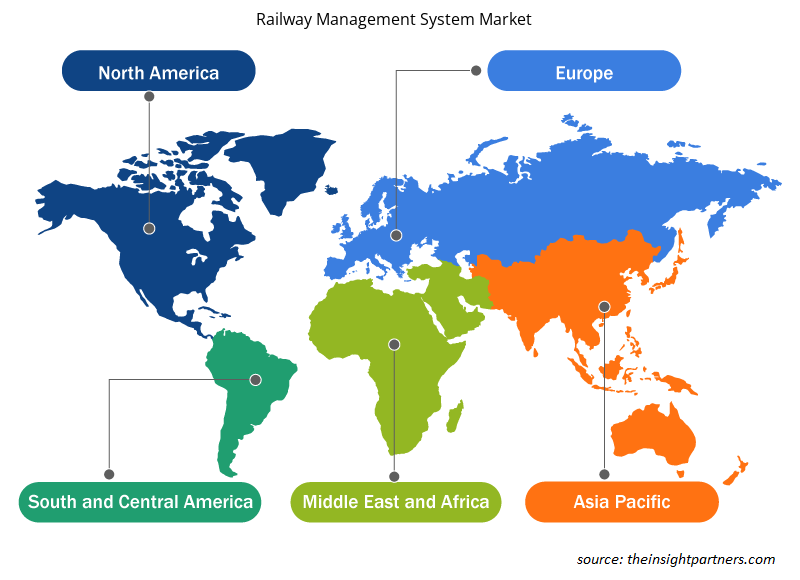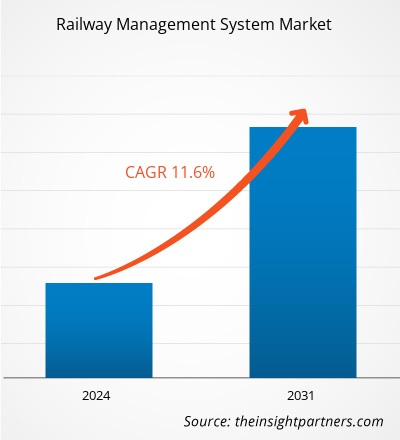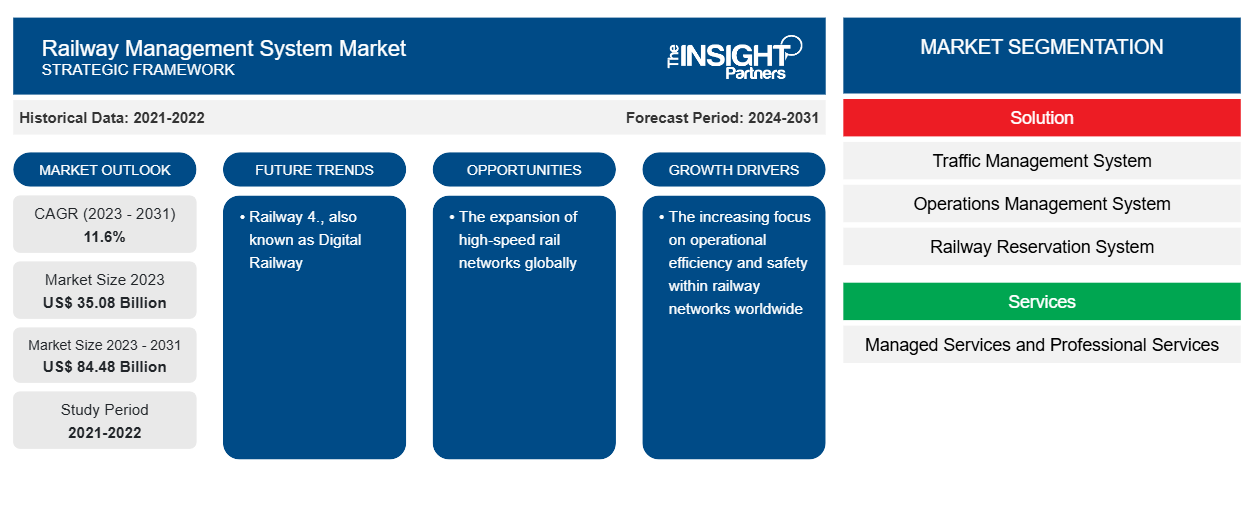La taille du marché des systèmes de gestion ferroviaire devrait atteindre 84,48 milliards USD d'ici 2031, contre 35,08 milliards USD en 2023. Le marché devrait enregistrer un TCAC de 11,6 % en 2023-2031. Le chemin de fer 4.0, également connu sous le nom de chemin de fer numérique, devrait rester l'une des principales tendances du marché des systèmes de gestion ferroviaire.
Analyse du marché des systèmes de gestion ferroviaire
Le marché des systèmes de gestion ferroviaire connaît une croissance en raison de diverses tendances en matière de développement des infrastructures et de technologies de transport. Ces systèmes se concentrent sur l'efficacité opérationnelle, l'amélioration de la sécurité et l'expérience des passagers plutôt que sur des fonctionnalités telles que la surveillance en temps réel et la maintenance prédictive. Plusieurs technologies stimulent le marché, notamment l'IA (intelligence artificielle), l'IoT (Internet des objets) et le cloud computing, qui permettent l'optimisation et la gestion à distance des opérations ferroviaires. Dans l'ensemble, le marché des systèmes de gestion ferroviaire est en croissance et en expansion à l'échelle mondiale, poussé par l'impératif d'améliorer l'efficacité, la sécurité et la durabilité des chemins de fer.
Aperçu du marché des systèmes de gestion ferroviaire
Un système de gestion ferroviaire englobe plusieurs processus et technologies permettant de gérer et d'exploiter efficacement les réseaux ferroviaires. Il comprend des composants tels que la gestion du fret, les systèmes de billetterie , les informations aux passagers, la planification des trains, la planification de la maintenance et la surveillance de la sécurité. Le système utilise des technologies avancées, telles que le GPS, les réseaux de communication et les capteurs IoT pour permettre d'optimiser la planification des itinéraires, d'assurer la sécurité et le suivi en temps réel des trains. Les services aux passagers sont améliorés grâce à la réservation de sièges, à la réservation de billets en ligne et aux mises à jour en temps réel des horaires des trains. En outre, les activités de maintenance sont rationalisées et les temps d'arrêt réduits et l'efficacité opérationnelle globale améliorée grâce à l'utilisation de techniques de maintenance prédictive.
Personnalisez ce rapport en fonction de vos besoins
Vous bénéficierez d'une personnalisation gratuite de n'importe quel rapport, y compris de certaines parties de ce rapport, d'une analyse au niveau des pays, d'un pack de données Excel, ainsi que de superbes offres et réductions pour les start-ups et les universités.
-
Obtenez les principales tendances clés du marché de ce rapport.Cet échantillon GRATUIT comprendra une analyse de données, allant des tendances du marché aux estimations et prévisions.
Moteurs et opportunités du marché des systèmes de gestion ferroviaire
L'accent croissant mis sur l'efficacité opérationnelle et la sécurité au sein des réseaux ferroviaires du monde entier
Avec l'augmentation du volume de passagers et de marchandises, les opérateurs ferroviaires se tournent vers des systèmes de gestion avancés pour optimiser la planification des trains, l'entretien des voies et les performances globales du réseau. Ces systèmes exploitent des technologies telles que les capteurs IoT, l'analyse prédictive et la surveillance en temps réel pour améliorer la sécurité, minimiser les retards et réduire les coûts d'exploitation. En améliorant l'efficacité et la fiabilité, les systèmes de gestion ferroviaire contribuent à répondre aux attentes croissantes des clients et aux normes réglementaires.IoT sensors, predictive analytics, and real-time monitoring to enhance safety, minimize delays, and reduce operational costs. By improving efficiency and reliability, railway management systems help meet rising customer expectations and regulatory standards.
L'expansion des réseaux ferroviaires à grande vitesse à l'échelle mondiale
De nombreux pays investissent dans la modernisation de leurs infrastructures ferroviaires pour soutenir les trains à grande vitesse, offrant des options de transport plus rapides et plus durables. Cette tendance crée une demande importante de solutions de gestion ferroviaire avancées capables de gérer des opérations complexes à des vitesses plus élevées et d'assurer une connectivité transparente entre différents réseaux ferroviaires. Alors que les projets de trains à grande vitesse continuent de se développer, le marché des systèmes de gestion ferroviaire innovants est sur le point de connaître une croissance substantielle. Ainsi, l'expansion des réseaux ferroviaires à grande vitesse à l'échelle mondiale devrait offrir de nouvelles opportunités aux acteurs du marché des systèmes de gestion ferroviaire au cours de la période de prévision.
Analyse de segmentation du rapport sur le marché des systèmes de gestion ferroviaire
Les segments clés qui ont contribué à l’élaboration de l’analyse du marché des systèmes de gestion ferroviaire sont la solution et le type de déploiement.
- Sur la base de la solution, le marché des systèmes de gestion ferroviaire est segmenté en système de gestion du trafic, système de gestion des opérations, système de réservation ferroviaire, système d'information des passagers, système de gestion de la maintenance et autres.
- Sur la base des services, le marché des systèmes de gestion ferroviaire est segmenté en services gérés et services professionnels.
- En fonction du type de déploiement, le marché est segmenté en sur site et en cloud. Le segment cloud détenait une part de marché plus importante en 2023.
Analyse des parts de marché des systèmes de gestion ferroviaire par zone géographique
La portée géographique du rapport sur le marché des systèmes de gestion ferroviaire est principalement divisée en cinq régions : Amérique du Nord, Asie-Pacifique, Europe, Moyen-Orient et Afrique, et Amérique du Sud/Amérique du Sud et centrale. En termes de chiffre d'affaires, l'Europe représente la plus grande part de marché des systèmes de gestion ferroviaire. En Europe, les réseaux ferroviaires établis et l'accent mis sur l'efficacité stimulent la demande de systèmes de gestion avancés qui améliorent la sécurité, la ponctualité et l'expérience des passagers. Des pays comme l'Allemagne et la France sont les premiers à adopter des technologies de pointe pour le contrôle, la signalisation et la maintenance des trains.
Aperçu régional du marché des systèmes de gestion ferroviaire
Les tendances et facteurs régionaux influençant le marché des systèmes de gestion ferroviaire tout au long de la période de prévision ont été expliqués en détail par les analystes d’Insight Partners. Cette section traite également des segments et de la géographie du marché des systèmes de gestion ferroviaire en Amérique du Nord, en Europe, en Asie-Pacifique, au Moyen-Orient et en Afrique, ainsi qu’en Amérique du Sud et en Amérique centrale.

- Obtenez les données régionales spécifiques au marché des systèmes de gestion ferroviaire
Portée du rapport sur le marché des systèmes de gestion ferroviaire
| Attribut de rapport | Détails |
|---|---|
| Taille du marché en 2023 | 35,08 milliards de dollars américains |
| Taille du marché d'ici 2031 | 84,48 milliards de dollars américains |
| Taux de croissance annuel composé mondial (2023-2031) | 11,6% |
| Données historiques | 2021-2022 |
| Période de prévision | 2024-2031 |
| Segments couverts |
Par Solution
|
| Régions et pays couverts |
Amérique du Nord
|
| Leaders du marché et profils d'entreprises clés |
|
Densité des acteurs du marché des systèmes de gestion ferroviaire : comprendre son impact sur la dynamique des entreprises
Le marché des systèmes de gestion ferroviaire connaît une croissance rapide, tirée par la demande croissante des utilisateurs finaux en raison de facteurs tels que l'évolution des préférences des consommateurs, les avancées technologiques et une plus grande sensibilisation aux avantages du produit. À mesure que la demande augmente, les entreprises élargissent leurs offres, innovent pour répondre aux besoins des consommateurs et capitalisent sur les tendances émergentes, ce qui alimente davantage la croissance du marché.
La densité des acteurs du marché fait référence à la répartition des entreprises ou des sociétés opérant sur un marché ou un secteur particulier. Elle indique le nombre de concurrents (acteurs du marché) présents sur un marché donné par rapport à sa taille ou à sa valeur marchande totale.
Les principales entreprises opérant sur le marché des systèmes de gestion ferroviaire sont :
- Bombardier Inc.
- Société de technologie DXC
- EKE-Electronics Ltd
- Compagnie Générale d'Électricité
- Hitachi, Ltée.
- Huawei Technologies Co. Ltd.
Avis de non-responsabilité : les sociétés répertoriées ci-dessus ne sont pas classées dans un ordre particulier.

- Obtenez un aperçu des principaux acteurs du marché des systèmes de gestion ferroviaire
Actualités et développements récents du marché des systèmes de gestion ferroviaire
Le marché des systèmes de gestion ferroviaire est évalué en collectant des données qualitatives et quantitatives après des recherches primaires et secondaires, qui comprennent d'importantes publications d'entreprise, des données d'association et des bases de données. Voici une liste des évolutions du marché des troubles de la parole et du langage et des stratégies :
- En août 2023, Toast, la plateforme technologique tout-en-un conçue pour les restaurants, a annoncé le lancement de Toast Catering & Events, un nouveau produit entièrement intégré au point de vente (POS) Toast pour aider les restaurants à gérer de manière transparente les commandes de restauration importantes et la planification d'événements. Toast Catering & Events prend en charge les commandes d'événements de banquet personnalisables (BEO), les outils de traitement des commandes et les fonctionnalités de gestion des prospects. (Source : Toast, communiqué de presse)
- En juin 2021, FoodStorm, le premier fournisseur mondial de logiciels de restauration, a annoncé le lancement de son FoodStorm Kiosk, un kiosque physique en libre-service permettant aux clients en magasin de passer des commandes de produits de restauration, de plats préparés, de charcuterie et de boulangerie avec un seul backend géré. (Source : FoodStorm, communiqué de presse)
Rapport sur le marché des systèmes de gestion ferroviaire : couverture et livrables
Le rapport « Taille et prévisions du marché des systèmes de gestion ferroviaire (2023-2031) » fournit une analyse détaillée du marché couvrant les domaines ci-dessous :
- Taille du marché et prévisions aux niveaux mondial, régional et national pour tous les segments de marché clés couverts par le périmètre
- Dynamique du marché, comme les facteurs moteurs, les contraintes et les opportunités clés
- Principales tendances futures
- Analyse détaillée des cinq forces de PEST/Porter et SWOT
- Analyse du marché mondial et régional couvrant les principales tendances du marché, les principaux acteurs, les réglementations et les développements récents du marché
- Analyse du paysage industriel et de la concurrence couvrant la concentration du marché, l'analyse de la carte thermique, les principaux acteurs et les développements récents
- Profils d'entreprise détaillés
- Analyse historique (2 ans), année de base, prévision (7 ans) avec TCAC
- Analyse PEST et SWOT
- Taille du marché Valeur / Volume - Mondial, Régional, Pays
- Industrie et paysage concurrentiel
- Ensemble de données Excel
Rapports récents
Rapports connexes
Témoignages
Raison d'acheter
- Prise de décision éclairée
- Compréhension de la dynamique du marché
- Analyse concurrentielle
- Connaissances clients
- Prévisions de marché
- Atténuation des risques
- Planification stratégique
- Justification des investissements
- Identification des marchés émergents
- Amélioration des stratégies marketing
- Amélioration de l'efficacité opérationnelle
- Alignement sur les tendances réglementaires























 Obtenez un échantillon gratuit pour - Marché des systèmes de gestion ferroviaire
Obtenez un échantillon gratuit pour - Marché des systèmes de gestion ferroviaire